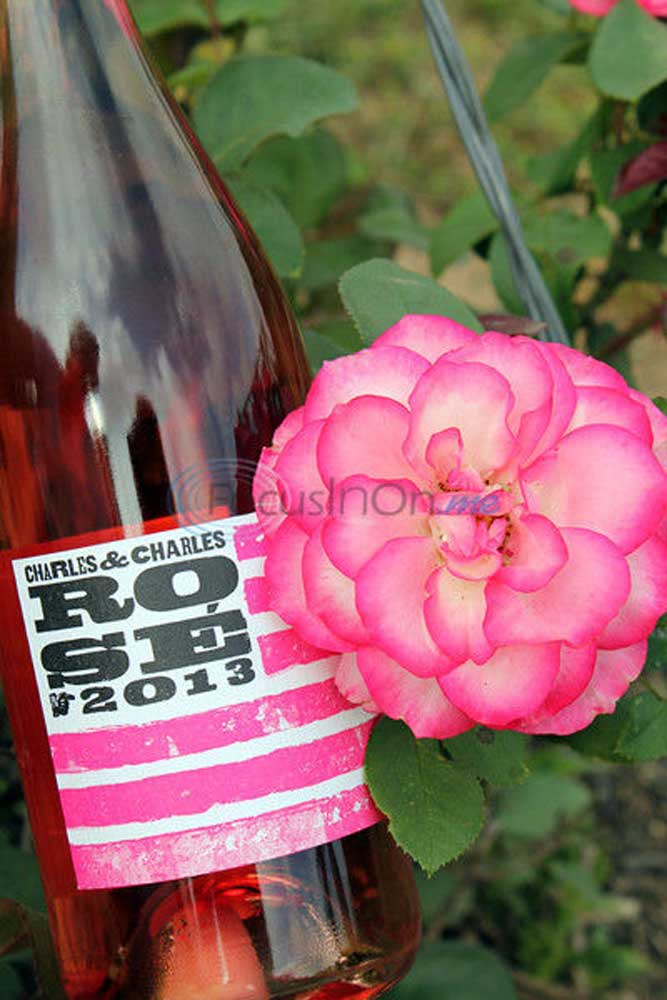Spring Wine: A rose by any other name is a rosé
Published 1:10 am Wednesday, April 30, 2014

- Christine Gardner/Staff Charles & Charles Rosé, Washington: A collaboration between winemakers, Charles Smith (K Vintners, Charles Smith Wines) and Charles Bieler (Three Thieves, Bieler Pere et Fils, Sombra Mezcal). The 2013 Rose is a vibrant pink in color with streaks of salmon and fuschia. A blend of syrah, cinsault, grenache, counoise and mourvedre, the grapes are sourced from a vineyard in Washington state’s Columbia Valley. Wild Strawberry and watermelon aromas are interwoven with herbs de Provence, citrus and mineral notes. These same flavors carry through to the palate where they intensify with a surprisingly broad and plush mouth feel that concludes with acidity. Pair with grilled salmon, halibut or pan-seared scallops.
May is bursting with blooming roses, and this sure sign of spring means the latest release of rosé wines are creating a burst of color on store shelves. Just like roses, they vary in shades of pink and their delicate flavor is just as subtle and beautiful as a rose’s petals.
But don’t be confused because a rosé by any other name is probably a blush or white zinfandel, which means something different in the wine industry. Not all pink is created equal in the wine industry.
In technical terms rosé is a dry wine made from red wine grapes that receive limited contact (hours versus days) with the grape skins. The skins are what give red wine it’s color. The rosé can vary in color from very light orange-pink to almost red depending on the length of exposure to the skin.
Rosé’s are sometimes referred to as blush wine because they have only received a blush of color, but the correct term would be rosé. Over the years the term ‘blush’ began to refer to sweeter pink wines like white zinfandel or white merlot, so within the industry, it’s not a preferred label for Rosé. Also, the technique for blush and white zinfandel sometimes involves blending white and red wine to create a desired color.
Rosé is considered a spring wine because the previous year’s vintage is ready for bottling in the first spring after harvest. They are typically aged for six months in stainless barrels.
They are young wines designed to drink within a year of purchase.
Most vintages are limited release because the grapes used in rosé are primarily grown to make red wine. Many are blends of multiple grape varietals the winery may have left on the vine after picking all they need for red wine. It’s often advised that if you find a rosé you like stock up while you can. Distributors usually sell out of popular rosé’s before mid-summer.
However there are several French winemakers in the Southern regions who devote their entire crop to rosé production. Currently, rosé is the fastest growing segment in the wine industry and these pink wines are gaining in popularity.
Their aromas vary from red berries, melon, grapefruit and herbs, and each of these elements are also reflected on the palate. The finish is dry with crisp acidity and an air of freshness.
When deciding what food to serve with a rosé lighter fare is best – shellfish, chicken, cod, flounder, salmon, salads, pasta with light sauces and aperitifs like cured meats, fruit and cheese.
Rosé winemakers recommend drinking these wines at a temperature of 42 to 53 degrees Fahrenheit. Whites and rosés are often drunk to cold because of storage in the refrigerator. A safe temperature range for the refrigerators is 35 to 40 degrees. This is generally too cold for appreciating all of the aromas and nuances of flavor in the wine.
A 20 minute rule is advised to ensure any wine is consumed at enjoyable temperature. For whites and rosés take the wine out of the refrigerator 20 minutes before serving. For reds, because Texas room temperature is too warm for wine, place the bottle in the refrigerator for 20 before serving.
The following list of notable rosés are now available available at FRESH by Brookshire’s and some Brookshire’s locations.
Crios Rosé of Malbec Argetina: Made completely from Malbec grapes, the most predominant grape varietal in Argentina. This rosé is deep in color and produced using the traditional ‘saignée’ method, a bleeding of the lightly colored juice from the skins of fermenting old-vine Malbec grapes. Argentine Malbec grapes create a richer, spicier wine than most other rosés from around the world.
This wine has a surprising amount of body for a rosé and beautiful aromas of fresh, ripe strawberries. Very soft, yet full on the palate with flavors of wild strawberries and young cherries accompanied by some spice notes and a clean, dry finish. Pairs well with chicken, spicy Asian cuisine light snacks and cheeses.
Editor Recommendation: Sometimes you may be tempted to serve a red with heavier fish such as salmon; however, this Rosé is the perfect alternative.
Mulderbosch, South Africa: First released in 1999, Mulderbosch Rosé was one of the very first of its kind from South Africa at a time when most rosés were a byproduct of red wine fermentation, Mulderbosch launched a varietal cabernet sauvignon rosé from specially farmed vineyards grown specifically for rosé production.
Displaying a pink color with lively hues, the nose combines aromas of ripe blood-orange, cherry and black currant cordial with fragrant sandalwood. The weighted palate balances juicy fruit flavors of fresh cherry and watermelon with acidity and finishes on a zesty note.
Aromatic yeasts heighten the vibrant, zesty aromas and fresh mineral palate. Crucial to this style of rosé is early bottling in order to preserve the wine’s freshness. It’s is the ideal summer salad wine and pairs well with seared tuna steaks, poached salmon, asparagus, quiche, cold shellfish, sushi and spring rolls.
Charles & Charles Rosé, Washington: A collaboration between winemakers, Charles Smith (K Vintners, Charles Smith Wines) and Charles Bieler (Three Thieves, Bieler Pere et Fils, Sombra Mezcal).
The 2013 Rose is a vibrant pink in color with streaks of salmon and fuschia. A blend of syrah, cinsault, grenache, counoise and mourvedre, the grapes are sourced from a vineyard in Washington state’s Columbia Valley.
Wild Strawberry and watermelon aromas are interwoven with herbs de Provence, citrus and mineral notes. These same flavors carry through to the palate where they intensify with a surprisingly broad and plush mouth feel that concludes with acidity. Pair with grilled salmon, halibut or pan-seared scallops.
Bieler Pere et Fils, Provence: From winemaker Charles Bieler, who also partners to produce Charles & Charles, this rosé is made in the traditional Provencal way by getting the grapes into the press within two hours of picking so there is limited skin-juice contact. The object is to emphasize freshness over density.
Fermentation is in stainless steel and concrete tanks and the wine is a blend of 55 percent syrah, 25 percent cabernet sauvignon and 20 percent grenache.
The grapes are harvested at night and within 2 hours very gently pressed to maximize the fresh, delicate aromas and light color. On the nose and palate it offers wild strawberry and watermelon following with a crisp finish.
Belleruche Cotes du Rhone, France: The Côtes du Rhône vineyard is one of the oldest in France. The vineyards of Belleruche rosé are located on old fluvioglacial terraces, on the right bank of the Rhône. The soil is composed of sand and clay and the wine comes mainly from Grenache, Cinsault and Syrah grapes. It’s slightly deeper in color with aromas and flavor in juicy cherry, melon and spice.
Marques de Caceres Rioja, Spain: Made from Tempranillo grapes, this wine has a deep red-pink color and notes of red currants, anise and lilies. Deliciously full in the mouth, it is juicy with versatile, refreshing character.
An ideal match for Mediterranean cuisine, grilled fish, pork and chicken, and all types of al fresco dining. Its versatility extends to sautéed vegetables, paella, pasta, and lightly spiced dishes.
Long Shadows Julia’s Dazzle Rosé, Washington: Founded by Allen Shoup, longtime CEO of Chateau Ste-Michelle, Long Shadows is a collection of wineries comprised of internationally acclaimed winemakers from the major wine regions of the world. Each winemaker is a partner in a unique winery dedicated to producing a single Columbia Valley wine representing a ‘best of type’ that reflects the winemaker’s signature style and the viticultural of Washington State’s Columbia Valley.
For Julia’s Dazzle Rosé, a block of Pinot Grigio grapes were reserved and given extended time on the vine to develop a bright tint through slow fermentation, then two percent of Sangiovese is blended for color.
Using a white grape as the predominant varietal in the process is unusual but this light pink wine offers aromas of strawberry and orange peel. It has a dry style but with sweet fruit flavors and clean sharp acidity creating a light and refreshing finish.
Centine Rosé, Toscana, Italy: Produced in hillside vineyards in the southern part of Tuscany. This wine is a blend of sangiovese, merlot and cabernet sauvignon. Its pink color is light and possesses a fresh bouquet with hints of woodland berries. With a dry finish, its berry flavors are well structured with a long crisp finish.
The grapes are vinified for 14 days, with brief skin contact, in stainless steel tanks at 64 degrees. The wine is ideal as an aperitif, it pairs perfectly with first courses, fish, poultry and young, mild cheeses.
Casal Garcia Vinho Verde Rosé, Portugal: Vihno Verde translates as green wine and is a regional designation wine from Northern Portugal. To produce the rosé, the wine uses vinhão, azal tinto and borraçal grapes that are grown in granitic, sandy coastal soil. The bright pink color of the wine reveals a fruity nose, characterized by fresh notes of strawberry, cherry and red berries.
The mineral qualities that coastal grapes possess make them a perfect pairing for shellfish.
Isabel Mondavi Deep Rosé, Napa Valley: Made from fully mature Napa Valley cabernet sauvignon fruit, it hails from a complex blend of prized Mondavi cabernet sauvignon vineyards.
Aromas of strawberry, cranberry and red apple fill the glass. It has a light mouth feel with waves of red fruit on the palate. Mouth-watering acidity complements a juicy finish.
It pairs well with a wide variety of dishes from spicy Thai cuisine to roasted salmon and Thanksgiving turkey. Enjoy lightly chilled with chocolates, or pour over ice with a spritz of sparkling water and a slice of blood orange to make an “Isabel Rocks” cocktail.






